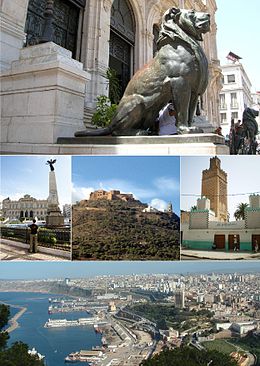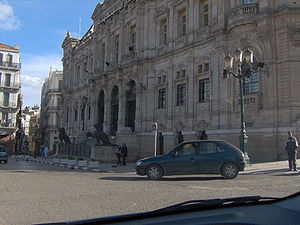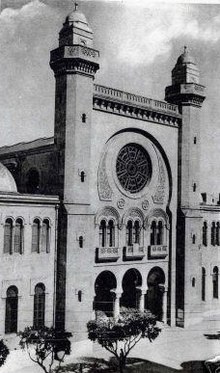| Oran وهران Wahrān | |||
|---|---|---|---|
| Top, the two Lions of Atlas (symbol of Oran), Center, 1st November Place, fort & chapel of Santa Cruz, Bey Othmane mosque, Bottom, general view | |||
| |||
| Nickname(s): The radiant " الباهية " | |||
| Coordinates: 35°41′49″N 0°37′59″WCoordinates: 35°41′49″N 0°37′59″W | |||
| Country | Algeria | ||
| Wilaya | Oran | ||
| Re-founded | AD 944 | ||
| Government | |||
| • Wali (Governor) | Saddek Benkada | ||
| Area | |||
| • City | 2,121 km2 (819 sq mi) | ||
| Elevation | 0.9 m (3 ft) | ||
| Population (1998 for city proper, 2010 for metro area)[1] | |||
| • City | 759,645 | ||
| • Metro | 1,454,078 | ||
| Time zone | CET (UTC+1) | ||
| Postal codes | 31000 - 31037 | ||
Oran (Arabic: وهران, Arabic pronunciation: [Wahrān]) is a major city on the northwesternMediterranean coast of Algeria, and the second largest city of the country.
It is the capital of the Oran Province(wilaya). The city has a population of 759,645 (2008[1]), while the metropolitan area has a population of approximately 1,500,000,[2] making it the second largest city in Algeria.[3]Oran is a major port, and since the 1960s has been the commercial, industrial, and educational centre of western Algeria.
History
Oran was founded in 903 by MoorishAndalusi traders[4] but was captured by the Spanish under Cardinal Cisneros in 1509. Spanish sovereignty lasted until 1708, when the city was conquered by theOttomans. Spain recaptured the city in 1732. However, its value as a trading post had decreased greatly, so King Charles IV sold the city to the Turks in 1792. Ottoman rule lasted until 1831, when it fell to theFrench.
During French rule over Algeria, Oran was the capital of a département of the same name (number 92). In July 1940, the British navy shelled French warships in the port after they refused a British ultimatum to surrender which was designed to ensure the fleet would not fall into German hands. The action increased the hatred of the Vichy regime for Britain but convinced the world that the British would fight on alone against Nazi Germany and its allies. The Vichy government held Oran during World War II until its capture by the Allies in late 1942, duringOperation Torch.
Before the Algerian War, 1954–1962, Oran had one of the highest proportions of Europeans of any city in North Africa. However, shortly after the end of the war, most of the Europeans and Sephardic Jews living in Oran fled to France. A massacre of Europeans, four days after the vote for Algerian independence, triggered the exodus to France. In less than three months Oran lost about half its population.
| Start year | End year | Event |
|---|---|---|
| 910 | 1082 | Oran became a perpetual object of conflict between the Umayyads of Spain and the Fatimides of Kairouan. |
| 1082 | 1145 | Presence of Almoravides. In 1145, Ibrahim ibn Tashfin perished in Oran while fighting against the already victorious Almohades troops in front ofTlemcen. |
| 1145 | 1238 | Presence of Almohades. 1147 marked the beginning of persecution against Oran's Jews. |
| 1238 | 1509 | Presence of the Zianides of Tlemcen and then the Marinid dynasty of Fes. The protection by the Emir, the customs system (tariffs), trade withMarseilles, and the Italian Maritime Republics of Genoa and Venice, with whom, in 1250, Oran signed a commercial treaty of forty year's duration, made the Oranians rich. So much so, that toward the end of the 14th century, celebrated Arab historian Ibn Khaldoun wrote the following, "Oran is superior to all other cities by its trade. It's a paradise for the unhappy one. Those who arrive poor in its walls, will leave it again rich." The city excelled in the exportation of lead, wool, skins, fine burnous, carpets, haïks, cumin, nuts, and galls, without forgetting the draft of black slaves. |
[edit]Spanish period
Before the Spaniards, the Portuguese launched a failed expedition to capture the city in July 1501. Four years later, the Spanish took Mers-el-Kébir, located just four miles to the west of the Oran. Thus began the first organized incursions against the city which, at the time, numbered 25,000 inhabitants and counted 6,000fueros. Count Pedro Navarro, on the orders of CardinalFrancisco Jiménez de Cisneros, captured the city on May 17, 1509.
By 1554, the Turks had reached Algiers, and then governor of Oran, Count Alcaudete, allied himself with Moroccan Sultan Mohammed ash-Sheikh against them. Nine years later, in 1563, Álvaro de Bazán, Marquis de Santa Cruz, built the fort of Santa-Cruz, strategically placed at the top of a mountain, l'Aïdour, more than 1,000 ft (300 m) above the sea, directly to the west of the city. Pedro Garcerán de Borja, Grand Master of the Order of Montesa, was captain of Oran when, on July 14, 1568, John of Austria (the illegitimate son of Charles I and thus the paternal half-brother of King Philip II), led a flotilla of 33 galleys against the Algerians.
In April 1669 the Spanish governor, the Marquis of del los Vélez expelled all the Jews who lived in Oran and Mers El Kébir[5] sending them to be resettled in either Nice, and Livorno.
The Spanish rebuilt the fortress of Santa Cruz Fort to accommodate their city governors. "The fortifications of the place were composed of thick and continuous walls of over two and a half kilometers in circumference, surmounted by strong towers spaced between them," with a central castle or kasbah where the Spanish governor established his headquarters. The city under Spanish rule continued to grow, requiring enlargement of the city walls. In spite of the improved fortifications, the city was the object of repeated attacks. Notable in this regard, Moroccan Sharif Moulay Ismail tried to force his way past the defenses in 1707, only to see his army decimated.
[edit]Ottoman period
The Spaniards occupied the city until 1708, when the Turkish Bey, Mustapha Ben Youssef (Bouchelaghem) took advantage of the War of Spanish Succession to drive them out.
In 1732, Spanish forces, under José Carrillo de Albornoz captured the city from Bey Hassan in the Battle of Aïn-el-Turk.
In the night after October 8, 1790, a violent earthquake claimed more than 3,000 victims in less than seven minutes. Thereafter Charles IV saw no advantage in continuing the occupation of the city, which had become increasingly expensive and perilous. He initiated discussions with the Bey of Algiers. A treaty handing over the city was signed on September 12, 1792. After another earthquake had damaged the Spanish defences, Bey Ben Othman's forces took possession of Oran on October 8 of the same year. In 1792, the Ottomans settled a Jewish community there. In 1796, the Pasha Mosque (in honour of Hassan Pasha, Dey of Algeria), was built by the Turks with ransom money paid for the release of Spanish prisoners after Spain's final departure. In 1830 the Beys moved their capital from Mascara to Oran.
[edit]French period
The town of 10,000 inhabitants was still in the possession of the Ottoman Empire, when a squadron under the command of captain Bourmand seized el-Kébir on December 14, 1830. The city was in a wretched state. On January 4, 1831, the French commanded by General Damrémontoccupied Oran. In September 1830 the King appointed a police chief with the function of mayor in Algiers. In September 1831, General Berthezènemade Mr. Pujol, captain of cavalry in retirement and wounded at the right hand under the Empire, mayor of Oran. In 1832, at the head of five thousand men, a young Emir calledAbd al-Qadir attacks Oran. In April 1833, commander-in-chief, General Boyer, leaves Oran and is replaced by the baron Louis Alexis Desmichels. The cities defenders,under attack by Abd el Kader, holds their ground .
- 1836, General Létang transforms the glacis Castle-Nine into a walk which bears its name. At the beginning of 1837 General Bugeaud arrives in Oran to negotiate a new treaty (The Treaty of Tafna, May 20) with Emir Abd El-Kader. On November 14 the Emir signs a treaty with Desmichel recognizing its authority to the west of Algiers except for Oran, Mostaganem and Arzew.
- 1845, Construction of the "Village Nègre" by General Lamoricière .
- 1847, Following a dramatic drought lasting several months, a terrible epidemic of cholera strikes and decimates a big part of the population of Oran.
- From 1848, Oran was the prefecture of the department of the same name. Creation of the small Basin of the Old Port (four hectares). A civil hospital is built.
- 1849, Construction of the vault of the Virgin to get rid of the cholera. The members of the first general council of Oran, named by Emperor Napoleon III, meet on December 5, 1858 with the prefecture, with Jules de Pre de Saint-Maur as chairman.
- 1866 July 25, Creation of the oran diocesis.
- 1880, Beginning of the construction of the Large synagogue of Oran. Oran builds a great extension starting from the place d'Armes. The ravine of l'Oued Rouina is filled.
- 1881, Appearance of the first horse drawn trams.
- 1886, Inauguration of Hotel de Ville, the City Hall.
- 1899, First electric trams.
- 1900, the city has 90,000 inhabitants.
- 1907, Construction of the theatre.
- 1909 December 14, the first flight in Oran is carried out by Julien Serviès on a Sommer monoplane at Sénia,. Next 9 January, a great meeting gathers forty thousand people, also in Sénia, in the presence of Marshal Lyautey.
- 1913, Opening to the worship of the Cathedral Sacré Coeur.
- 1918, Dedication of the Great Synagogue of Oran
- 1930, Creation of new districts, less dense and more luxurious, completing the urbanisation of the first crown, in its part directed towards the interior of the country; these districts are higher Gambetta, Bon Reception, the Beavers, Médioni, Small Boulanger, Cité... This development continues overall with the creation of districts even more sumptuous, overflowing the first crown (district of Saint-Hubert, Palm trees, Point of the Day, Gambetta...)
- 1930–32, Sénia, the Oran aérodrome, is where several world records of duration and distance in closed loop are established.
- 1940, Beginning of the construction of the new prefecture.
- 1940 July 3, Part of the French fleet of the Atlantic based at Mers el Kébir, is bombarded while at anchor by the British fleet coming from Gibraltar, causing the loss of three battleships: Dunkerque,Provence and Bretagne. One thousand two hundred French sailors perish. The British feared that if France totally capitulated to Hitler the French fleet could be taken over and used against them.
- 1942 November 8, as prelude to the invasion of Italy the British and the Americans land at Arzew and Oran capitulates on November 10.
- 1950, Oran has 256,661 inhabitants. Sixty-five percent of the total of Europeans is of Spanish origin more than the total number of Muslims in the city.
- 1957, Construction of the municipal stage named "Fouques-Duparc", with a capacity of forty-five thousand.
- 1958 June 6, visit by French president General Charles de Gaulle.
- 1960, First barricades.
- 1961 August, appearance of the Organisation de l'armée secrète. The census states the population of Oran 400,000 inhabitants: 220,000 Europeans and 180,000 Muslims.
- 1962, Recrudescence of the attacks. One of the chiefs of the OAS, Edmond Jouhaud, is arrested on March 25. In June he sets fire to port with ten million tons of fuel darkening the sky of the city. The Algerian reaction, later known as the Oran massacre of 1962, ended the French presence in the city.
[edit]In independent Algeria
| This section is empty. You can help byadding to it. (March 2012) |
[edit]Etymology
The word derives from the Berber root 'HR meaning lion(see also Tahert and Souk Ahras). The name is attested in multiple Berber languages, for instance as uharu and ahra. A locally popular legend tells that in the period around 900 BC, there were sightings of lions in the area. The two last felines were killed in a mountain near the city of Oran, which is now known as La montagne des Lions ("The Mountain of Lions"). In fact, there are two giant lion statues in front of Oran's city hall, hence the twin lions' mountain is Oran's symbol.
[edit]Oran today
Today, Oran is a major port and a commercial centre, and has three universities. The old quarter of Oran has a casbah and an 18th century mosque.
Oran has become a major trading centre for the wider area, serving Arzew, the areas oil/gas port as well as Sonatrach, the countries biggest oil and gas company. Sonalgas has built a new congress centre in Oran and in 2010 the 16th International Conference & Exhibition on Liquefied Natural Gas will be held in the city of Oran, which is expected to attract around 3,000 visitors and major companies from around the world. To accommodate all visitors, new hotels are currently being constructed and floating hotels will be used in addition.
Culture
The folk music Raï ("opinion" in Arabic), had its beginnings in Oran. This genre of music was formulated by shepherds in the 1930s through Arab and European influences. This music was surrounded by controversy due to women's key role in public performances of the music, as well as the hedonistic lyrics about love and alcohol. This led to strict governmental control in the area which led to arrests, injuries, and assassinations.[7] Many notable Raï musicians (including Cheb Hasni, Cheb Khaled and Rachid Taha) hail from Oran. The violinist Akim el Sikameya was also born in Oran.
[edit]Fiction
El Gallardo Español 1615 by Miguel de Cervantes and Albert Camus's 1947 novelThe Plague take place in Oran.
Part of Arturo Pérez-Reverte's 2006 Capitán Alatriste adventure novel Corsarios de Levante (Pirates of the Levant) takes place in early 17th-century Oran. The action of the book occurs just a few years after the forced expulsion of last Moriscos (Spanish Muslims) from Valencia. There are vivid descriptions of Oran as a sun-blasted North African military stronghold, largely forgotten by the King of Spain and his advisors, whose attention is focused on the wars in the Low Countries and the treasure fleets from the Americas. Fictional hero Capitán Diego Alatriste and his ward Íñigo Balboa find Oran to be manned by an impoverished garrison of Christian Spaniards, living alongside Muslims (some fiercely loyal to Spain), and Sephardic Jews, themselves refugees from the 1492 expulsions ordered by the Catholic Monarchs (Ferdinand and Isabel).
In the movie Casablanca, the route for refugees fleeing to the Americas was Paris toMarseille, across the Mediterranean to Oran, then by train, auto or foot to Casablanca. If they were lucky enough to get an exit visa, they went on to Lisbon from there.
In the ITV Drama Series Hornblower Lieutenant Hornblower is sent by Captain Pellew to Oran in order to obtain supplies, only to discover that Oran is suffering from Bubonic Plague and have to spend 3 weeks on board an abandoned supply ship enroute toGibraltar loaded with the supplies obtained from Oran, as a sort of quarantine.
Paul Bowles's 1949 novel The Sheltering Sky takes place mainly in Oran.
The heroine of Geraldine Brooks' novel Year of Wonders ends up in Oran after a year in a village under a self-imposed quarantine fighting the plague in 1666.












No comments:
Post a Comment